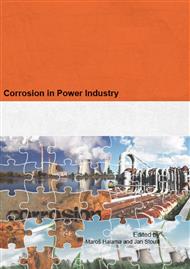[1]
Z. Meng, D. Wu, L. Wang, H. Zhu, Q. Li, Carbon nanotube glycol nanofluids: Photo-thermal properties, thermal conductivities and rheological behavior, Particuology, 10 (2012) 614-618.
DOI: 10.1016/j.partic.2012.04.001
Google Scholar
[2]
I. Palabiyik, Z. Musina, S. Witharana, Y. Ding, Dispersion stability and thermal conductivity of propylene glycol-based nanofluids, Journal of Nanoparticle Research, 13 (2011) 5049-5055.
DOI: 10.1007/s11051-011-0485-x
Google Scholar
[3]
R. Saidur, K.Y. Leong, H.A. Mohammad, A review on applications and challenges of nanofluids, Renewable and Sustainable Energy Reviews, 15 (2011) 1646-1668.
DOI: 10.1016/j.rser.2010.11.035
Google Scholar
[4]
E.V. Timofeeva, W. Yu, D.M. France, D. Singh, J.L. Routbort, Base fluid and temperature effects on the heat transfer characteristics of SiC in ethylene glycol/H2O and H2O nanofluids, Journal of Applied Physics, 109 (2011) 014914.
DOI: 10.1063/1.3524274
Google Scholar
[5]
H. Xie, W. Yu, W. Chen, MgO nanofluids: higher thermal conductivity and lower viscosity among ethylene glycol-based nanofluids containing oxide nanoparticles, Journal of Experimental Nanoscience, 5 (2010) 463-472.
DOI: 10.1080/17458081003628949
Google Scholar
[6]
Y. Xuan, Q. Li, Heat transfer enhancement of nanofluids, International Journal of Heat and Fluid Flow 21 (2000) 58-64.
DOI: 10.1016/s0142-727x(99)00067-3
Google Scholar
[7]
J. -C. Yang, F. -C. Li, Y. -R. He, Y. -M. Huang, B. -C. Jiang, Experimental study on the characteristics of heat transfer and flow resistance in turbulent pipe flows of viscoelastic-fluid-based Cu nanofluid, International Journal of Heat and Mass Transfer, 62 (2013).
DOI: 10.1016/j.ijheatmasstransfer.2013.02.074
Google Scholar
[8]
G. Żyła, M. Cholewa, A. Witek, Rheological properties of diethylene glycol-based MgAl2O4 nanofluids, RSC Advances, 3 (2013) 6429.
DOI: 10.1039/c3ra40187a
Google Scholar
[9]
R. Kathiravan, R. Kumar, A. Gupta, R. Chandra, Preparation and pool boiling characteristics of copper nanofluids over a flat plate heater, International Journal of Heat and Mass Transfer, 53 (2010) 1673-1681.
DOI: 10.1016/j.ijheatmasstransfer.2010.01.022
Google Scholar
[10]
V. Suryanaryanan, R.T. Tom, A.S. Nairn, T. Pradeep, Electrochemical investigations of oxide coated nanoparticles, Proceedings of the National Academy of Sciences A, 70 (2004) 483-488.
Google Scholar
[11]
X. Wei, L. Wang, Synthesis and thermal conductivity of microfluidic copper nanofluids, Particuology, 8 (2010) 262-271.
DOI: 10.1016/j.partic.2010.03.001
Google Scholar
[12]
J. Leitner, M. Kamarádek, Termodynamický popis nanosystémů, Chemické Listy, 107 (2013) 606–613.
Google Scholar
[13]
L. Tang, X. Li, R.C. Cammarata, C. Friesen, K. Sieradzki, Electrochemical Stability of Elemental Metal Nanoparticles, Journal of American Chemical Society, 132 (2010) 11722–11726.
DOI: 10.1021/ja104421t
Google Scholar


